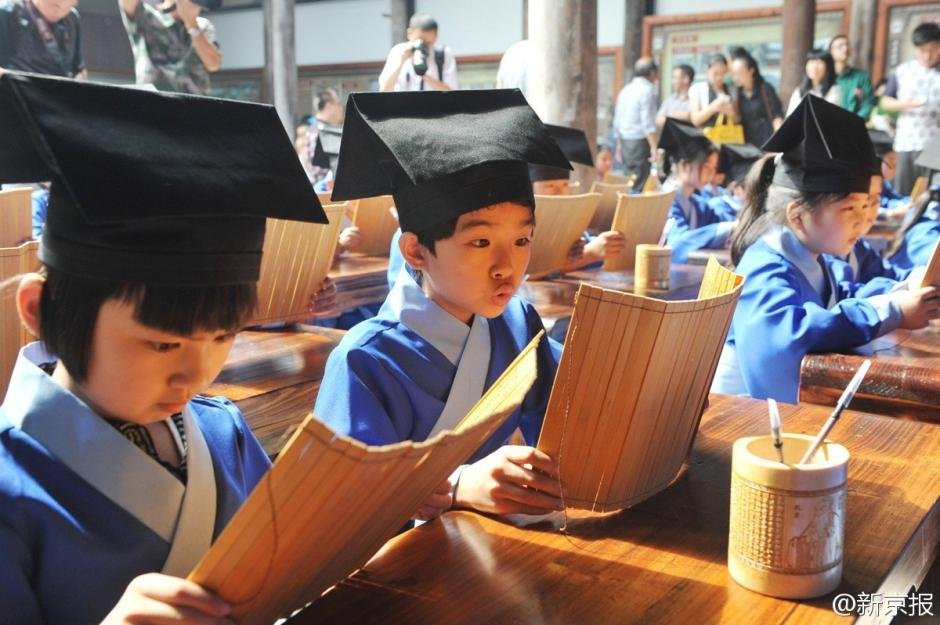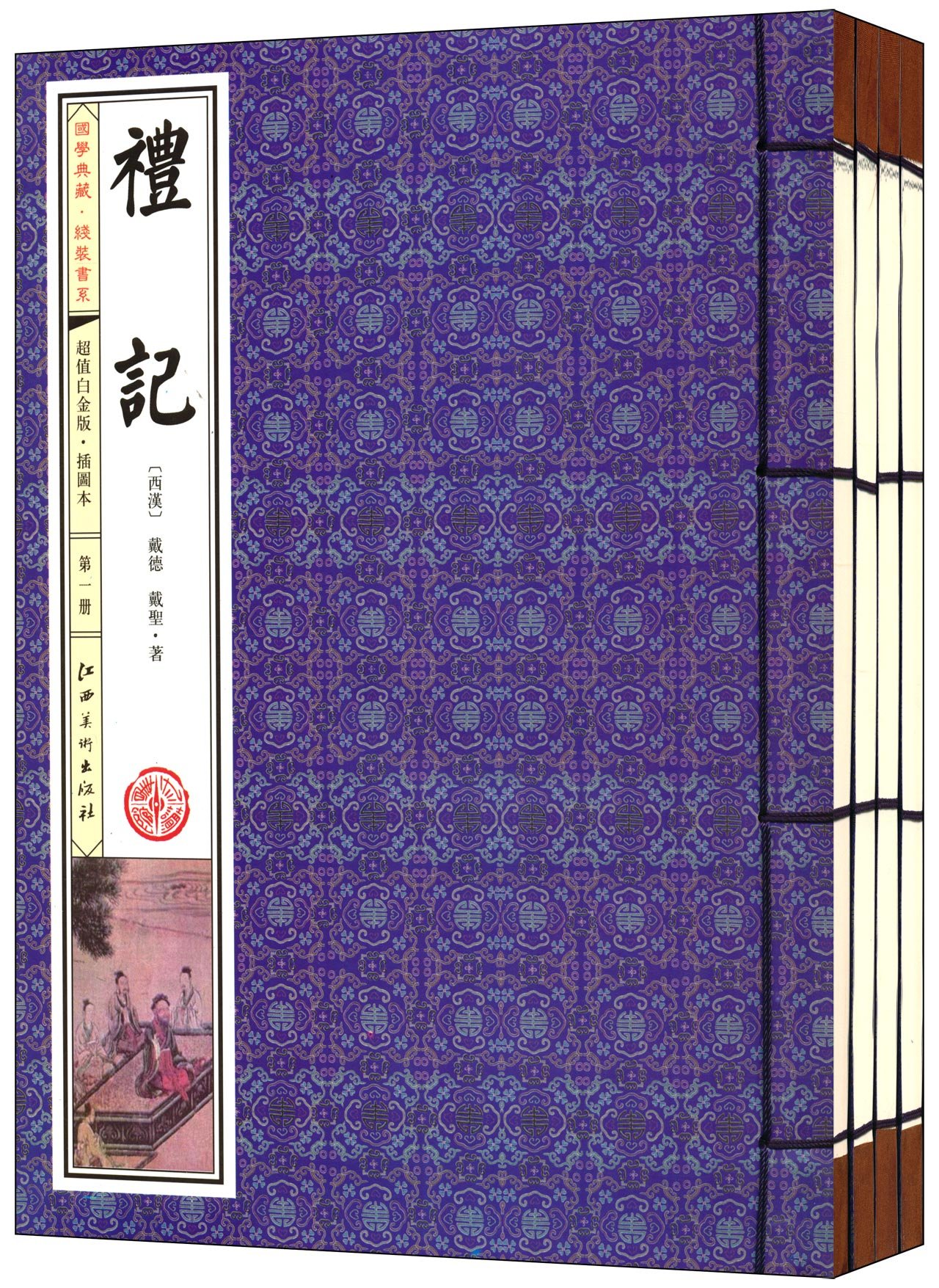Ritual system continues to bind China in present

Dressed in Han costumes, students recite the classic text Rules for Students (Di Zi Gui) to learn about traditional ettiquette in the Confucious school in Lin’an City, Zhejiang Province. (PHOTO: XINHUA)

The Book of Rites or Liji
Some believe that since ancient times, autocratic power has created a moral vacuum, so the Chinese ritual system is to blame and needs to be abandoned entirely. Others argue that the lack of etiquette and the moral vacuum are the results of the infiltration of Western culture.
However, the two viewpoints reflect a fuzzy understanding of the features and values of the Chinese ritual system as well as a lack of confidence in cultural heritage.
Historical heritage
The Chinese ritual system that has been passed on by generations of Chinese people includes important social codes of conduct and crystallized records of spiritual experience. It has been a prerequisite for interpersonal, intertribal and state-to-state communication over the long course of historical development.
The opening chapter of Qu Li in the Book of Rites states, “always and in everything, let there be reverence,” stressing the importance of mutual respect in social interactions. Chinese people have gradually come to recognize and accept the etiquette code over thousands of years of development as a civilization, which has led to proper integration and common development. The principle of “harmony as a treasure” is learned in a hard way. “In judging of rites, the times should be the greatest consideration” is the guideline the Chinese ritual system has followed, because only by adapting to the changing times can the ritual system prosper and preserve its legacy.
When Liu Bang, known commonly throughout China as Emperor Gaozu, established the Han Dynasty (206 BC-AD220), he showed little interest in traditional rules of propriety. However, Confucian scholars convinced Gaozu to adopt the inherited customs and etiquette system built upon on the foundation of rites and etiquette codes in the Qin Dynasty (221-206BC).
History confirms that the Chinese ritual system is a fine cultural tradition and an important heritage that has been thriving with the nation and has also played a positive role in guiding society since ancient times.
Ethnic recognition
In the Wei, Jin and the Southern and Northern dynasties (220-581), the Yuan Dynasty (1206-1368) and the Qing Dynasty (1616-1911), ethnic tribes took over the central plains. Although they adopted policies that were not conducive to national reconciliation within a certain period, they eventually turned to Chinese customs and etiquette for the sake of promoting social progress and economic development.
For example, when the Xianbei ethnic group established the Northern Wei Dynasty (386-534), it copied the Han state’s rites for the heaven worship sacrificial ceremony and modified its calendar to shore up its reign’s legitimacy. Later, Emperor Xiaowen appointed Han scholars to reform the ritual system.
Likewise, the Yuan and Qing dynasties implemented national policy that antagonized the Han Chinese but ultimately adopted the Chinese ritual system, which resulted in the reconciliation of subjugated Han and other ethnic tribes. History once again confirmed that the Chinese ritual system was of vital significance for achieving national reconciliation and social development.
Geographical applicability
In ancient times, people of different tribes had their own living area, language and customs, but they were somehow influenced by Han etiquette and ritual culture during mutual interaction and communication, particularly in dealings with the Han. Gradually, they began to recognize and follow traditional etiquette codes to achieve the integration of the Chinese people.
As the tale goes, in the period of Three Kingdoms (220-280), Zhuge Liang, a great strategist who served the Shu kingdom, captured and freed tribal leader Meng Huo in Southwestern China seven times. Zhuge Liang treated Meng Huo with respect each time in order to achieve his genuine acquiescence. Meng did not surrender to the military power of the Shu, but to Zhuge Liang’s courtesy and righteousness.
In fact, etiquette has been an important tool of feudal rule since ancient times. Rulers attached great importance to etiquette, and they educated officials and ordinary people alike via local clans. Some scholars even published works to promote Chinese customs and etiquette, such as Shu Yi by Sima Guang, a Northern Song Dynasty (960-1127) historian, and Jia Li by Zhu Xi, a Confucian scholar in the Southern Song Dynasty (1127-1279).
Afterward, the Chinese ritual system spread from the central plains to surrounding regions, so that people across China had a solid foundation and a fine example to learn from. In this sense, it is an indisputable fact that the Chinese ritual system played a crucial role in maintaining feudal rule.
Openness and inclusiveness
In the formation, transformation and development of Chinese ritual, it has proven to be not a closed and exclusive system but rather an open one. The Chinese ritual system was first established in the Qin Dynasty, when customs and practices in the central plains of China gradually integrated those of the surrounding tribes, forming a code of morality and practice at the state level.
For example, the “Five Rites” system originated from Zhou Li, a book of rites for the Zhou Dynasty (1046-256BC), but it only became institutionalized with categories, such as auspicious, inauspicious, fine, guest and military, in the Book of Jin or Jinshu, an official record of the Jin Dynasty (265-420). It was further completed in the Tang Dynasty (618-907) by absorbing the fine elements of the surrounding tribes, serving as the main ceremonial reference for later dynasties.
In the late Qing and early Republican era, as Western civilization was introduced to China, the Chinese ritual system absorbed some Western etiquette, which enriched its content. Obviously, its openness enabled the Chinese ritual system to adjust its structure, innovate, develop and stand firm in accommodating other civilizations.
Inclusiveness and openness complement each other. In its development process, the Chinese ritual system absorbed the best elements of different cultures, thus reducing conflict and achieving coexistence and common prosperity. Many examples in history can demonstrate this feature.
As mentioned above, Emperor Xiaowen reformed the ritual system, albeit putting the “Five Rites” of the Han nationality at its core. But he no doubt had included parts of the traditions of the Tuoba tribe. In addition, imperial court music and dance in the Tang Dynasty absorbed the essence of the neighboring states as well as ethnic tribes, making themselves almost perfect.
Indeed, throughout Chinese history, there are also cases of rejecting exotic culture. Emperor Kangxi in the Qing Dynasty took an isolationist stance toward Western etiquette and foreign culture, which was maintained by his successors Yongzheng and Qianlong, separating China from the development of the world. The later Western invasions and humiliation left us a lesson that must be learned and remembered.
Morality in practice
The Chinese ritual system is not merely a national system. It is the moral norms that we follow in social interactions. Confucius raved about ancient Chinese sages who endeavored to pursue high moral standards. He believed “one could not stand on his feet if he does not learn etiquette.”
Learning and following etiquette while “behaving the way one tells others they ought to behave” demonstrates the practical significance of the Chinese ritual system as well as the mainstream value of ancient Chinese people. Moral cultivation and the practices that the Chinese ritual system emphasized are forms of cultural soft power that promote the building of moral character, enhance cohesiveness and encourage harmonious social development.
The historical heritage of the Chinese ritual system has guaranteed its status in Chinese culture. Ethnic recognition and geographical applicability have proven its roots in China, allowing it to serve as historical evidence and an ideological weapon to fight against national separatism. Openness and inclusiveness ensure the survival and development of the Chinese ritual system in the multi-polar world. The moral standards it promoted are of contemporary significance in terms of encouraging people to pursue courtesy and righteousness.
The courtesy and righteousness that the Chinese ritual system advocates are essential to unite all nationalities in China. The spirit of “cultivating one’s moral character in order to attain benevolence” and the faith of creating social harmony and stability can serve as the academic basis for the modern etiquette system, to promote national spirit, socialist core values as well as realize the great rejuvenation of the Chinese nation.
Tang Qinfu is a professor at Shanghai Normal University.
